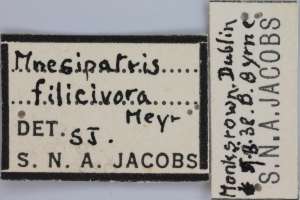

 +6Kontinente:EU
+6Kontinente:EU1. Falter
2. Diagnose
2.1. Geschlecht nicht bestimmt
2.2. Erstbeschreibung
3. Biologie
3.1. Nahrung der Raupe
- [Dryopteridaceae:] Polystichum setiferum (Grannen-Schildfarn, Borstiger Schildfarn)
- [Dryopteridaceae:] Dryopteris filix-mas (Wurmfarn)
- [Aspleniaceae:] Phyllitis scolopendrium (Hirschzungenfarn, Hirschzunge)
- [Aspleniaceae:] Asplenium ruta-muraria ? (Mauerraute)
Schon in der Erstbeschreibung ist von Raupenfunden an Wurmfarn die Rede, ähnlich bedeutend scheint noch der Grannen-Schildfarn zu sein.
The Glamorgan Moth Recording Group (2005) [PDF auf sewbrec.org.uk] geht in ihrem “Newsletter No. 83 – July 2005” auch auf das Thema “Status of Psychoides verhuella and Psychoides filicivora in Glamorgan“ ein. Dort heißt es: “The main foodplants of P. filicivora in Glamorgan seem to be Soft-shield Fern (Polystichum setiferum), and Malefern (Dryopteris filix-mas), but it has also been found on Harts-tongue (Phyllitis scolopendrium).” Und “In it Drane states that he found the larva of P. verhuella on Wall-rue (Asplenium ruta-muraria). However in Moths and Butterflies of Great Britain & Ireland Vol. II, p160 the editors state in history and distribution that this could well be a misidentification for P. filicivora, especially in the larval state and that the host plant: stated as Wall-rue, would be more likely with P. filicivora. This now clashes somewhat with an extraordinary find at Maesteg in June 2005 when P. verhuella was found on Wall-rue. Both imago and larvae were found in numbers on several occasions [see photo gallery]. It’s usual given food-plant is harts-tongue, which it has been found on in Monmouthshire [vc35], with spleenwort (Asplenium spp.) and rustyback (Ceterach officinarum) as other documented plants.”
Zumindest bei der Hirschzunge und der Mauerraute muss in Großbritannien also mit beiden Arten der Gattung Psychodes gerechnet werden, möglicherweise noch an weiteren Farnen.
4. Weitere Informationen
4.1. Abweichende Schreibweisen
- Psychoides filicivorus [nach Artikel 32.1. des International Code for Zoological Nomenclature korrekte Schreibweise mit Übereinstimmung des grammatikalischen Geschlechts von Gattungs-Substantiv und Art-Adjektiv oder -Partizip]
4.2. Andere Kombinationen
- Mnesipatris filicivora Meyrick, 1937 [Originalkombination]
4.3. Faunistik
Gaedike & Karsholt (2001) erbrachten auf Madeira den ersten Nachweis der Art außerhalb der Britischen Inseln.
(Autor: Erwin Rennwald)
4.4. Literatur
- Gaedike, R. & O. Karsholt (2001): Contribution to the Lepidoptera fauna of the Madeira Islands. Part 2. Tineidae, Acrolepiidae, Epermeniidae. — Beiträge zur Entomologie 51 (1): 161-213 [PDF auf zobodat.at].
- Erstbeschreibung: Meyrick, E. (1937): A new species of Lamproniadae (Microlepidoptera) from Ireland. — The Entomologist 70 (892): 194, pl. IV.













